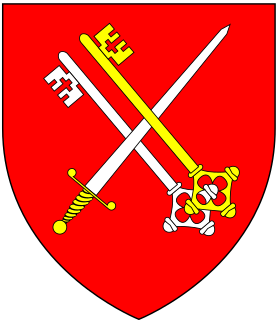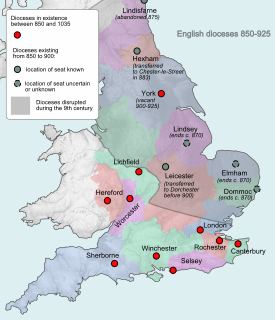Related Research Articles
Waldric was the eighth Lord Chancellor and Lord Keeper of England, from 1103 to 1107. He was also Bishop of Laon from 1106 to 1112. He had been a royal chaplain as early as 3 September 1101.
William FitzGilbert was the fifteenth Lord Chancellor of England, from 1141 to 1142, serving the Empress Matilda.
Richard le Gras was Lord Keeper of England and Abbot of Evesham in the 13th century.
Aldred of Lindisfarne was Bishop of Lindisfarne, perhaps dying around 968.
Sir Robert Parning was an English lawyer and administrator.

The Bishop of Winchester is the diocesan bishop of the Diocese of Winchester in the Church of England. The bishop's seat (cathedra) is at Winchester Cathedral in Hampshire. The Bishop of Winchester holds ex officio the office of Prelate of the Most Noble Order of the Garter since its foundation in 1348, and Bishops of Winchester often held the positions of Lord Treasurer and Lord Chancellor ex officio. During the Middle Ages, it was one of the wealthiest English sees, and its bishops have included a number of politically prominent Englishmen, notably the 9th century Saint Swithun and medieval magnates including William of Wykeham and Henry of Blois.
John Blund was an English scholastic philosopher, known for his work on the nature of the soul, the Tractatus de anima, one of the first works of western philosophy to make use of the recently translated De Anima by Aristotle and especially the Persian philosopher Avicenna's work on the soul, also called De Anima. He taught at Oxford University along with Edmund of Abingdon. David Knowles said that he was "noteworthy for his knowledge of Avicenna and his rejection of the hylomorphism of Avicebron and the plurality of forms.", although the problem of the plurality of forms as understood by later scholastics was not formulated explicitly in Blund's time. Maurice Powicke calls him the "first English Aristotelian."
Æthelric was Bishop of Durham from 1041 to 1056 when he resigned.
Ætla, who lived in the 7th century, is believed to be one of many Bishops of Dorchester during the Anglo-Saxon period. The village of Attlebridge, Norfolk is named after him, as he is credited for the construction of a bridge there.
Ælfwold was a medieval Bishop of Crediton.
Cuthwine was a medieval bishop of Dunwich in England.
Ealdbeorht may have been a medieval Bishop of Dunwich.
Aethelweald was a medieval Bishop of Elmham.
William de Beaufeu was a medieval Bishop of Thetford and a major landholder mentioned in the Domesday Book.
Eadmund was a 9th-century Englishman. It had been thought he had been Bishop of Winchester between 833 and 838. However, following further studies he is no longer listed to have been bishop.
Frithestan was the Anglo-Saxon Bishop of Winchester from 909 until his resignation in 931.
John Scarle was keeper of the rolls of Chancery from 1394 to 1397 and Archdeacon of Lincoln before being named Lord Chancellor of England in 1399. He held that office until 9 March 1401. He was also Clerk of the Parliament between November 1384 and February 1397.
Wulfsige was a medieval Bishop of Cornwall.
Æthelred was a medieval Bishop of Cornwall.

The Bishop of Dunwich is an episcopal title which was first used by an Anglo-Saxon bishop between the seventh and ninth centuries and is currently used by the suffragan bishop of the Diocese of St Edmundsbury and Ipswich. The title takes its name after Dommoc in the English county of Suffolk, which has now largely been lost to the sea.
References
- Powicke, F. Maurice and E. B. Fryde Handbook of British Chronology 2nd. ed. London:Royal Historical Society 1961
| Christian titles | ||
|---|---|---|
| New title new foundation | Bishop of Leicester 679–c. 691 | Succeeded by Wilfrid |